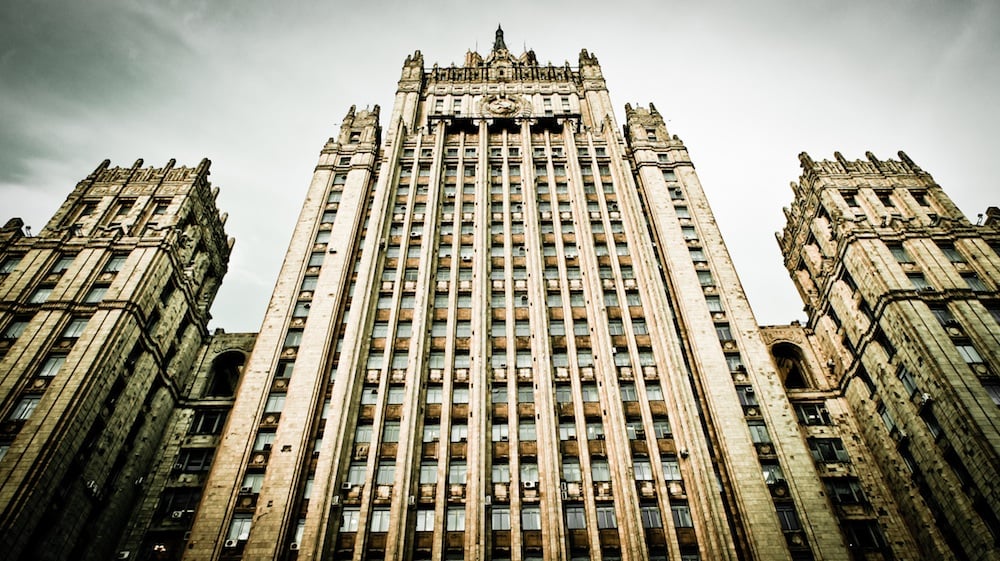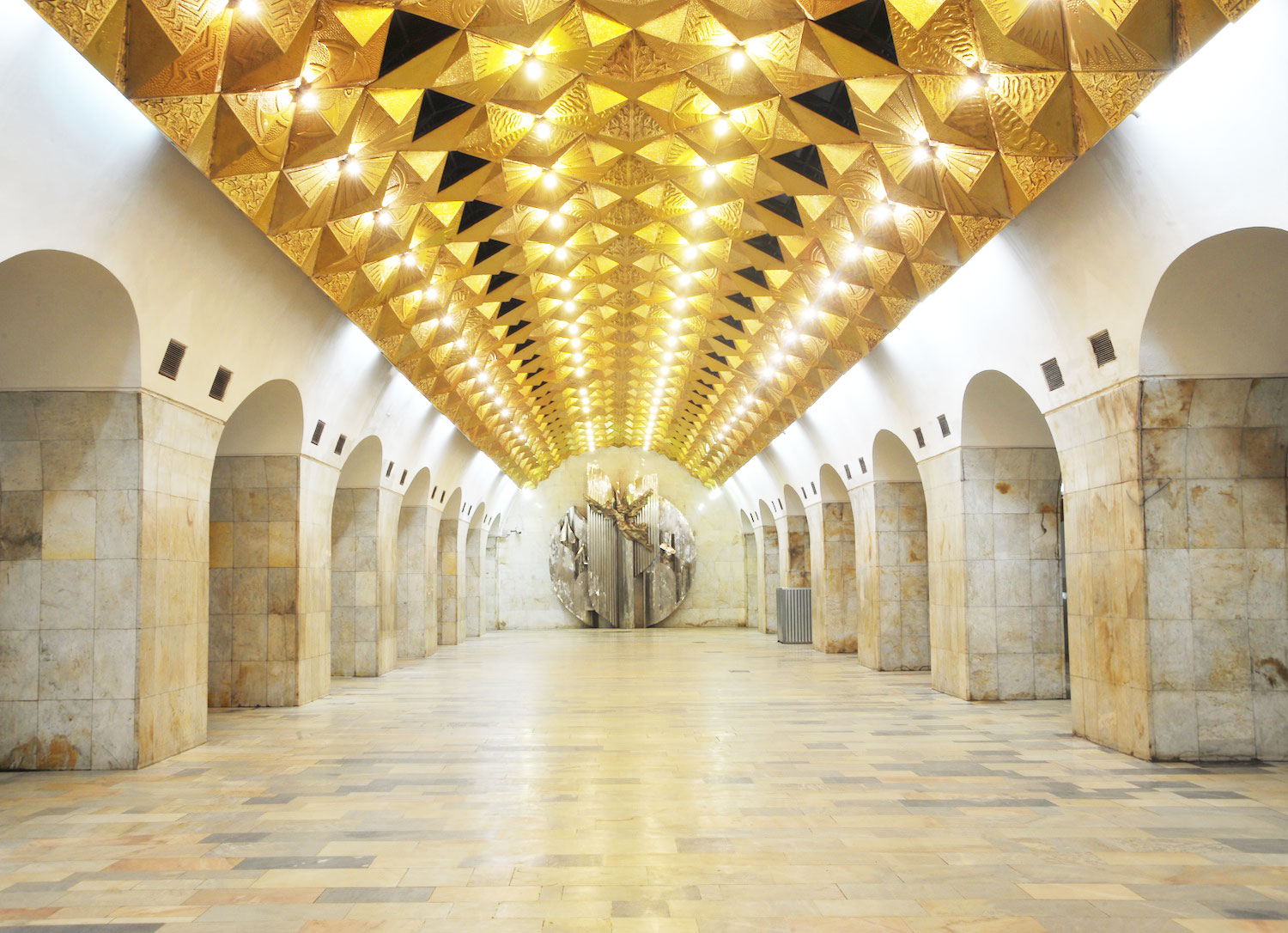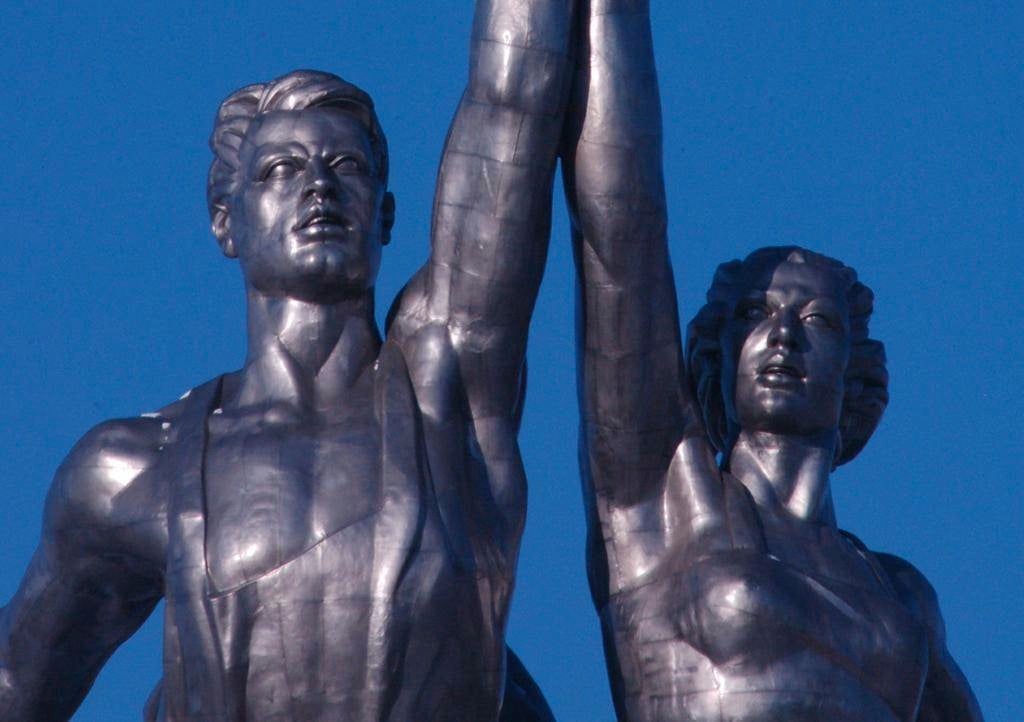Holy appropriate: why Pussy Riot and the Cathedral of Christ the Saviour are a match made in heaven
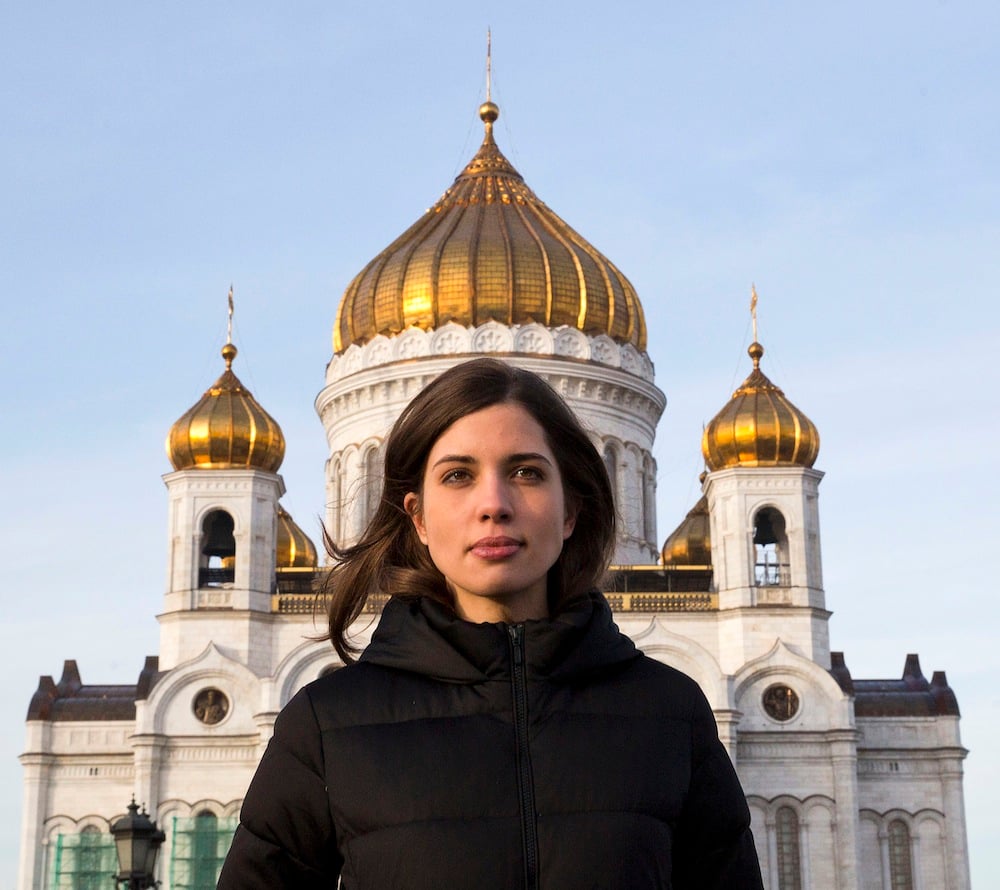
The Cathedral of Christ the Saviour — destroyed by Stalin, rebuilt by Luzhkov — is a symbol of Moscow's changing landscape, both real and ideological. What's more, argues Eliot Borenstein, it has a lot in common with the scandalous punks that made it infamous
Within hours of her triumphant return to Moscow, pardoned Pussy Riot member Nadezhda Tolokonnikova returned to the scene of her alleged crime: the Cathedral of Christ the Saviour, the giant white and gold church that was rebuilt in the Nineties and which dominates the skyline. In a photo that was shared around the world, her face — no longer masked in a balaclava — is perfectly framed by the church’s gold cupolas. Tolokonnikova is not dwarfed by her backdrop, as in a typical tourist photograph. Instead, it seems, she has partially eclipsed it.
The standard liberal response to Pussy Riot’s notorious “punk prayer” in the cathedral has been something like: “Of course, I don’t approve of doing something like that in a church, but their punishment is unjust.” This is the familiar civil libertarian stance that supports a right to do the outrageous while keeping the perpetrators at a safe distance. But this approach misses the point: it is precisely the Cathedral of Christ the Saviour as a venue that justifies Pussy Riot’s action.
This is because the cathedral itself is the incarnation of scandal; in its designs, redesigns, demolitions and reconstructions, it is not just an appropriate site for conceptual art — it is conceptual art performed in extremely slow motion; it is not just a site of scandal, to many it is itself a scandal. Thus the Cathedral of Christ the Saviour is the material foundation of the cultural logic of Pussy Riot.
For a cultural landmark that has been so prominent in the international news, Moscow’s Cathedral of Christ the Saviour is a strangely unstable site. Indeed, despite the countless tons of stone utilised in its (re)construction, the cathedral has an uncanny tendency to vanish, as if it were an architectural illustration of Jean Piaget’s notion of object impermanence — like a child playing peekaboo, how do we know it’s still there when we can’t see it? The cathedral is cultural significant precisely as the physical manifestation of disappearance, the materialisation of the threat of dematerialising. We all recall the famous “Vanishing Commissar” of Soviet photographs: the airbrushing of fallen leaders became a touchstone for the Soviet Union’s unstable past. The cathedral, by encompassing a pre-Soviet pre-history, a Soviet demolition, and a post-Soviet reconstruction widens this concept of historical instability, allowing it to span over a century of Russian culture.
“The Cathedral of Christ the Saviour is tantamount to taking an Indian burial ground, building a shopping mall on top of it, and then knocking down the shopping mall in order to replace it with a sparkling new Indian burial ground”
The cathedral has become a shorthand for historical change, as seen in Far Side of the Moon (2011), the Russian remake of cult British television series Life on Mars. The premise of Life on Mars is that, after suffering an accident, a 21st-century British police detective wakes up in the Seventies and has to function in an utterly different world of law enforcement. Far Side of the Moon does roughly the same thing, but taps a much richer vein of cultural confusion by sending a contemporary Russian cop back to Soviet times: after being hit by a car, Moscow detective Misha Solovyov wakes up in 1979, a temporal shift that is conveyed by the reappearance of the Moscow open-air swimming pool that used to occupy the site of the cathedral.
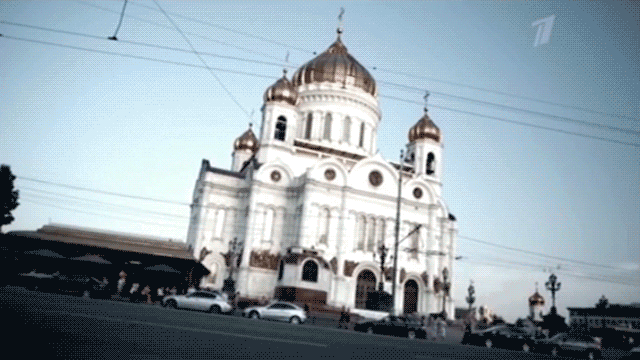
The cathedral transforms into a cathedral in the blinking of an eye in Far Side of the Moon
The shift from cathedral to pool in the blink of a concussed eye is jarring. We move from the presumably sacred to the decidedly profane (as anyone who ever swam in the pool’s less than pristine water can testify). The sacred is not a thing, but rather a matter of perception: it is always there for us to find, and always on the verge of being lost again.
In its initial conception, the Cathedral of Christ the Saviour was to be the synthesis of Russia’s national and spiritual destinies — a commemoration of Moscow’s survival in the face of the Napoleonic invasion in 1812. Initially a neoclassical project chock-full of Masonic symbolism, the cathedral was redesigned under Nicholas I in the Russian Revival style. Consecrated in 1883, it was desecrated in 1930 — first it was stripped of its gold, and, finally, on 5 December 1931, dynamited in a public spectacle. Even as the religious basis for the cathedral’s importance was negated by official Soviet atheism, its status as a (secular) sacred site was only bolstered by the plans to replace it with the Palace of Soviets, a grandiose Bolshevik Tower of Babel with an enormous statue of Lenin at its summit, like an abandoned groom on top of a Stalinist wedding cake.
The demolition of the Cathedral of Christ the Saviour in 1931
The planning and construction of this giant was fraught with problems and eventually interrupted by the outbreak of World War Two. Its frame was, like the gold of its predecessor, cannibalised for more practical use. It was transformed into the immense inversion of its original design: instead of a tower with one person on top, it would become the world’s largest open-air pool, with thousands of people bathing at a given time (a secular parody of the mass baptism of the Kievan Rus in 988). In the late Nineties, the cathedral was reconstructed, initially intended as a near-exact replica but eventually revised due to the input of the reliably tacky Zurab Tsereteli.
“The availability of parking and the discrete charms of a gift shop are particularly jarring within the Eastern Orthodox context”
Every structure on the site is part of an architectural palimpsest of state power and the sacred. Even at a single moment in time, the cathedral/pool exists as a snapshot in an imaginary timelapse photograph; one imagines a Duchamp pastiche, Cathedral Descending a Staircase. The pool is more than a pool, because its very existence reinforces the desecration of the vanished cathedral. The rebuilt cathedral is either the triumph of a resurgent, state-forming Orthodoxy or the site of a near-criminal disregard for the separation of church and state (not to mention a stark rejection of over 100 years of modern architecture). In that regard, the current building can be seen as the synthesis of a series of church/state alternations: the cathedral has fulfilled its destiny as an entity of both church and state, sanctifying the state in the eyes of hardliners, or profaning the church in the eyes of sceptics.
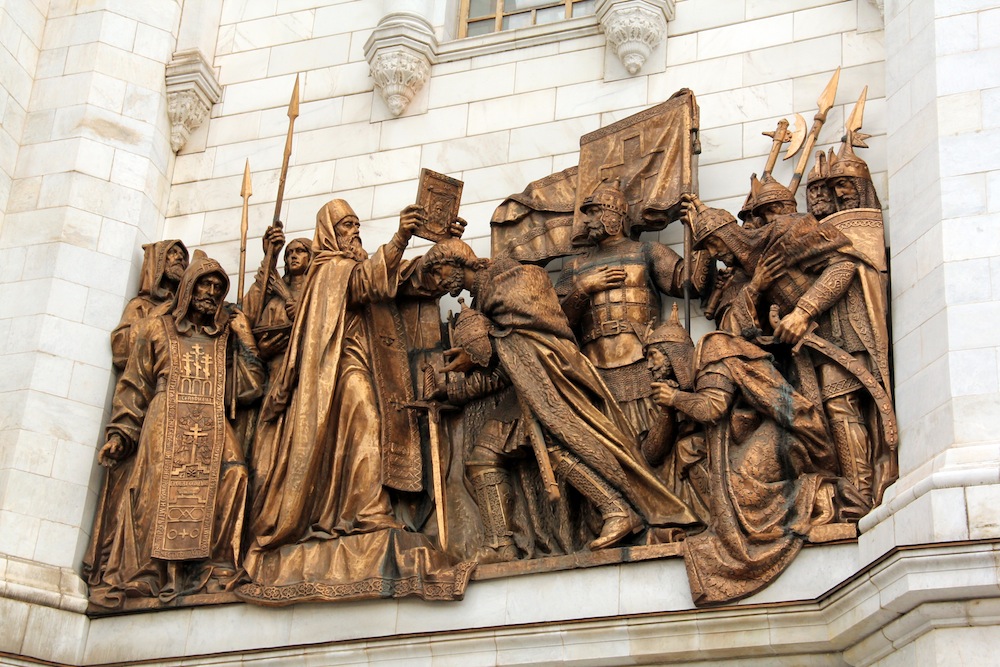
Elaborate decoration on the outside of the cathedral. Photograph: Ana Paula Hirama under a CC licence
Before a site was chosen for the Palace of Soviets, Bolshevik leader Sergei Kirov proposed that it be built “on the sites of palaces once owned by bankers, landlords and tsars”. The selection of the cathedral’s former location would appear to contradict Kirov’s idea; the Russian Orthodox Church was strangely absent from this list. But the new cathedral embodies Kirov’s hopes perfectly, albeit for ideological unfriendly purposes. The addition of a business centre to the church compound (seen by insiders as separated by a secular firewall, and as outsiders as part of a seamless whole), the availability of parking, and the discrete charms of a gift shop are particularly jarring within the Eastern Orthodox context. The Orthodox Church is traditionally a place of holy mystery. And, most famously, Patriarch Kirill has used the cathedral as the site of sermons calling on the faithful to vote for Putin (this being one of the primary justifications for Pussy Riot’s selection of Christ the Saviour as a performance venue). Add in the complex finances of the cathedral’s reconstruction (with the direct involvement of former Moscow mayor Yuri Luzhkov), and we clearly have a cathedral that is both more and less than a cathedral.
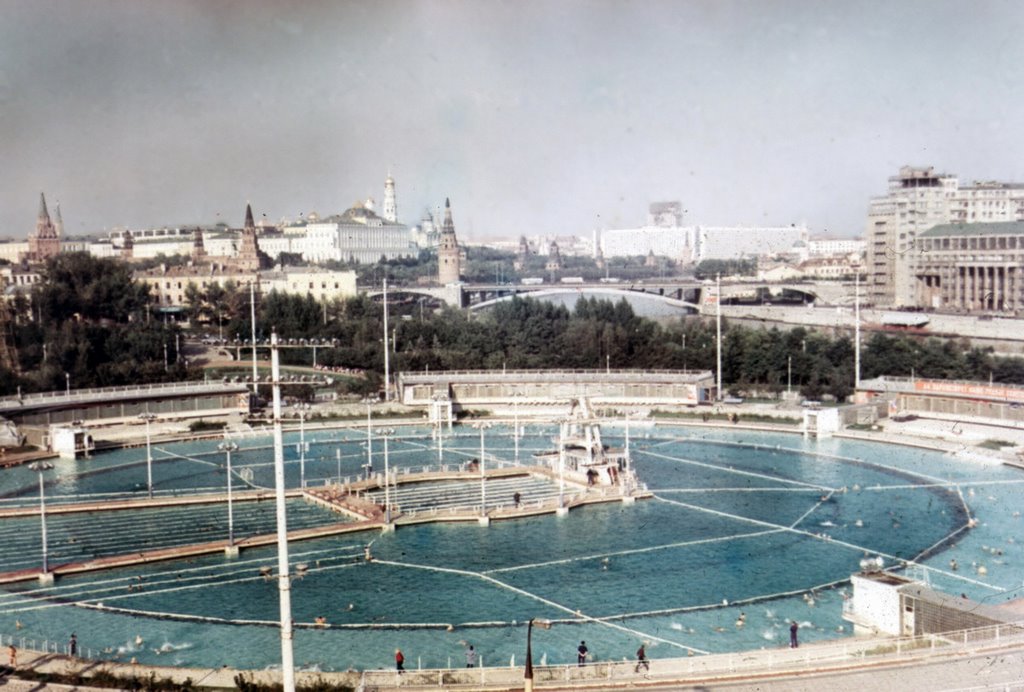
Swimming Pool Moskva, on the site of the once-and-former cathedral, in 1969
The Cathedral of Christ the Saviour is “haunted” by the ghosts of the past, and more specifically by the ghosts of architecture either razed or left unbuilt. The donation boxes scattered throughout Moscow in the Nineties were usually accompanied by images of the demolished cathedral, functioning as both an advertisement for the future and a memorial for a departed loved one.
“The Cathedral of Christ the Saviour is a haunted house story just waiting for the ghosts to arrive”
Haunted sites in the US are often those that signify a violation through the redefinition of use: churches repurposed as stores or homes, or the proverbial Indian burial ground paved over to make way for a suburban gated community. That is, haunting results from retasking, multitasking, and desecrating a pre-industrial site saturated with. The Cathedral of Christ the Saviour is tantamount to taking an Indian burial ground, building a shopping mall on top of it, and then knocking down the shopping mall in order to replace it with a sparkling new Indian burial ground — with a casino attached. From this perspective, the Cathedral of Christ the Saviour is a haunted house story just waiting for the ghosts to arrive.
And arrive they did. Liberal critics of the Pussy Riot trial are appalled by what they perceive as a medieval, obscurantist framework used by the witnesses and the prosecution. We are repeatedly told that the women made “satanic” movements, that their dancing was “diabolical”, and that the “girls” were possessed. There was even talk of exorcism. Those who laugh at such sentiments are missing the point. In fact, they are failing to recognise the critical acumen displayed by these alleged philistines, who display an almost instinctive understanding of the genre in which their story unfolds. On its own, the performance of the punk prayer is pure actionism, but on the site of so much historical and architectural revisionism, the prayer becomes the poltergeist phenomenon for which this site has waited for decades.
